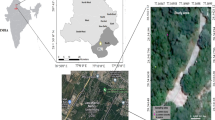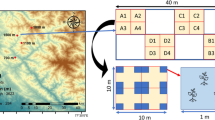Abstract
Eupatorium adenophorum is one of main invasive plants in China and has caused great economic losses. A study was conducted to determine the biomass allocation, leaf morphology and growth response of E. adenophorum seedlings that grew under five different intensities (relative irradiances RI 10%, 20%, 30%, 55%, 100%) for 14 months. Results reveal that the species shows typical leaf morphological adaptation to different light conditions. The total biomass of seedlings increased with the increase of light intensity from 10% to 55% RI but decreased at RI 100% (full sunlight). Height growth increased with the increase of light intensity from 10% to 30% RI but decreased when light intensity was over 30% RI. At low light levels, plants enhanced light availability by means of increasing biomass allocation to leaves and formation of larger, thinner leaves with high specific leaf area (SLA), leading to a high leaf area ratio (LAR) and high stem strips length (SSL). The mean relative growth rate (RGR) of the plant increased with the light intensity increase and attained the maximum at 55% RI. The growth of seedlings at 30%–55% RI was much better than that at full light condition. This might be an adaptive strategy that supports the vigorous invasiveness of this species, because a high-shaded canopy could prevent other plant species from surviving and growing. This study indicates that E. adenophorum could adapt to different light conditions, especially to low light habit. This can explain its greater invasiveness.
Similar content being viewed by others
References
Bazzaz, F.A. 1996. Plant in changing environments: linking physiological, population and community ecology. London: Cambridge University Press, 13–40.
Bazzaz, F.A. 1996. The effect of nutrient availability on biomass allocation patterns in 27 species of herbaceous plants. London: Cambridge University Press, 13–40.
Cain, M.L. 1994. Consequences of foraging in clonal plant species [J]. Ecology, 75(4): 933–944.
Feng Yulong, Cao Kunfang, Feng Lizhi and Ma Ling. 2002. The morphological and physiological acclimation of four tropical rainforest tree species to light regines [J]. Acta Ecologica Sinica, 22(7): 901–910. (in Chinese)
He Chiquao, Zhao Kuiyi and Yu Guoying. 1999. Reproductive strategy and ecological adaptation of clonal plant in wetlands [J]. Journal of Ecology, 18(6): 38–46. (in Chinese)
Kelly, C.K. 1990. Plant foraging: a marginal value mode and coiling response in Cuscuta subinclusa [J]. Ecology, 71(5): 1916–925.
Kroon de, H. and Hutchings, M.J. 1995. Morphological plasticity in clonal plants: the foraging concept reconsidered. [J]. Journal of Ecology, 83: 143–152.
Larcher, W. 1995. Physiological plant ecology [M]. Berlin: Springer-Verlag, 15–50.
Li Bo, Yang Chi and Ling Peng. 2000. Ecology [M] Beijing: Higher Education Press, 21–41, 89–90. (in Chinese)
Li Zhenyu and Xie Yan. 2002. Invasive Alien Species in China. [M]. Beijing: China Forestry Publishing House, 27, 65.
Liang Li and Zhong Zhangcheng. 2004. The adaptation of photosynthesis of 4 chimbing plants to different irradiance [J]. Journal of Southwest China Normal University (Natural science edition), 29(5): 856–859. (in Chinese)
Lu Daiwen. 2000. SPSS V10.0 for Windows [M]. Beijing: Publishing House of Electronics Industry. (in Chinese)
Maherali, H. and DeLucia, E.H. 2002. Influence of climate-driven Shifts in biomass allocation on water transport and storage in ponderosa pine. [J]. Oecologia, 129: 481–489.
Müller, I., Schmid, B. and Weiner, J. 2000. The effect of nutrient availability on biomass allocation patterns in 27 species of herbaceous plants [J]. Perspectives in Plant Ecology, Evolution and Systematics, 3: 115–117.
Niinemets, B., Valladares, F. and Ceulemans, R. 2003. Leaf-level phenotypic variability and plasticity of invasive Rhododendron ponticum and non-invasive Ilex aquifolium co-occurring at two contrasting European sites [J]. Plant, Cell and Environment, 26: 941–956.
Poorter, L. 1999. Growth response of 15 rain-forest tree species to a light gradient: the relative importance of morphological and physiological traits [J]. Functional Ecology, 13: 396–410.
Poorter, L. 2001. Light-dependent changes in biomass allocation and their importance for growth of rain forest tree species [J]. Functional Ecology, 15: 113–123.
Shan Baoqing., Du Guozhen. and Liu Zhenheng. 2000. Clonal growth of Ligularia virgaurea: morphological responses to nutritional variation [J]. Acta Photoecological Sinica, 24(1): 46–51. (in Chinese)
Smith. H. 1982. Light quality, photo perception and plant strategy [J]. Annual Review of Plant Physiology, 33: 481–518.
Standish, R.J., Robertson, A.W. and Williams, P.A. 2001. The impact of an invasive weed Tradescantia fluminensis on native forest regeneration [J] Journal of Applied Ecology., 38: 1253–1263.
Sun Xiaoyu, Lu Zhaohua, Sang Weiguo. 2004. Review on studies of Eupatorium adenophorum: an important invasive species in China [J]. Journal of Forestry Research, 15(4): 319–322.
Sutherland, W.J. and Stillman, R.A. 1988. The foraging tactics of plants. Oikos, 52: 239–244.
Wang Junfeng and Feng Yulong. 2004. The effect of light intensity on biomass allocation, leaf morphology and relative growth rate of two invasive plants [J]. Acta Phytoecologica Sinica, 28(6): 781–786. (in Chinese)
Wang, Shasheng, Gao Rongfu and Wu Guanming. 1991. Plant biology [M]. Beijing: China Forestry Publishing House, 284–286. (in Chinese)
Xu Zhenhao and Wang Yiping 2004. Disastrous mechanisms and control strategies of alien invasive plants [J]. Chinese Journal of Ecology, 23(3):124–127
Zhang Weiying, Wang Bosun, Li Mingguang, et al. 2002. The effect of different light intensity on the growth and morpha of Micrantha kunth seedlings [J]. Sun YaTsen University Forum, 22(1): 222–226. (in Chinese)
Author information
Authors and Affiliations
Additional information
Foundation item: This study is supported by Doctor Fund Project of Education Department (20050290003), Knowledge Innovation Project of Chinese Academy of Sciences (KSCX1-SW-13-0X-0X) and the National Natural Science Foundation of China (30470337).
Biography: SUN Xiao-yu (1973–), female, Ph. D candidate in the Institute of Restoration Ecology, China University of Mining and Technology, Beijing 100083, P. R. China.
Rights and permissions
About this article
Cite this article
Sun, Xy., Lu, Zh., Li, Ph. et al. Ecological adaptation of Eupatorium adenophorum populations to light intensity. J. of For. Res. 17, 116–120 (2006). https://doi.org/10.1007/s11676-006-0027-z
Received:
Accepted:
Issue Date:
DOI: https://doi.org/10.1007/s11676-006-0027-z




